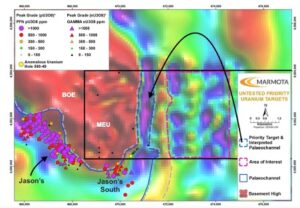Huge uranium potential on Marmota side of Boss’s Jasons deposit
Mining
Mining
Special Report: Marmota’s review of its Junction Dam uranium project has a new high priority exploration target immediately adjacent to Boss Energy’s high grade Jason’s deposit in South Australia.
While Junction Dam already boasts a 5.4Mlb uranium oxide resource at an average grade of 557ppm U3O8 within the Saffron deposit – similar in grade to Boss Energy’s (ASX:BOE) adjacent Honeymoon mine – there is clearly room for growth as the project bookends both sides of the palaeochannel that runs through Honeymoon.
This led Marmota (ASX:MEU) to launch a four-part review led by well-known yellowcake expert Mark Couzens late last year to unleash its potential and design the Junction Dam re-start drill program.
Earlier stages highlighted two Namba Formation paleochannels with uranium mineralisation at the base of the channel, similar to Heathgate Resources’ Beverly uranium mine, as well as two Eyre Formation paleochannels.
It also identified an extensive and intriguing paleochannel at the Yolanda prospect.

The area covered by the Stage 4 review. Pic: Supplied (MEU)
The final stage of the review, which focused on the northwest corner of Junction Dam, has now identified a new high-priority uranium exploration target immediately adjacent to BOE’s Jason’s deposit (10.7Mlbs U3O8 @ 790ppm U3O8) which is also Boss’s highest grade uranium resource.
State gravity imagery was used to identify potential extensions of the uranium-carrying Jason’s paleochannel across to MEU’s side of the tenement.

Interpretation of the Jason’s region showing priority drilling region on the Marmota side of the tenement boundary
This data showed the presence of a large basement high around which the paleochannel flows.
Both Jason’s and Jason’s South are located in a depression along the Yarramba paleovalley at the edge of a large basement high.
The same or similar depression then continues and extends north into the Marmota tenement.
A second larger zone to the east of the priority target has been identified as an area of interest with similar looking depressions to the main target area.
While the new areas are almost entirely untested, a hole drilled by Sedimentary Uranium in 1972 reported an anomalous gamma radiation reading on the edge of the target depression.
“The NW corner of Junction Dam has always been a tantalising target. We now have our first real understanding of the potential of the target area, and the priority targets, adjacent to the area that yields Boss its highest resource grades,” MEU chairman Dr Colin Rose said.
“We are delighted with the tantalising imagery that has emerged from the state gravity analysis when combined with the known paleochannels, and the potential for Marmota.
“The four-stage uranium review has dramatically changed our concept of the potential, scale and size of Junction Dam. It has been enormously successful. Focus will now turn to preparing the first restart drill program at Junction Dam.”
This article was developed in collaboration with Marmota, a Stockhead advertiser at the time of publishing.
This article does not constitute financial product advice. You should consider obtaining independent advice before making any financial decisions.